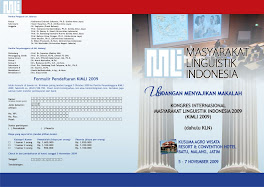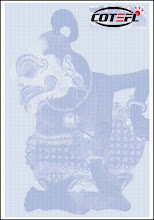EXPANDED DIMENSIONS TO LITERATURE IN EFL : AN INTEGRATED APPROACH
Budiati
Dr. Soetomo University
fs_budiati@yahoo.com
Abstract
Literature is language in use, and therefore it cannot be separated from language. For Widdowson (1975) literature “contributes significantly to both the process and the purpose of language learning.” Linguistically, literature can help students master the vocabulary and grammar of the language as well as the four language skills: reading, writing, listening, and speaking. Culturally, literature provides exposure to the culture of its speakers by examining universal human experience within the context of a particular setting and the consciousness of a particular people. Aesthetically, literature expresses the most significant ideas and feeling of human beings. Therefore, the study of literature can integrate all of the language skills with one another, with exposure to English-speaking cultures, and with increased literary understanding and appreciation. This paper focuses on Literature and
Key words : expanded dimensions, integrated approach, authentic material
I. Introduction
Literature is language in use, and therefore it cannot be separated from language. It is widely accepted that literature is recognized as an effective tool in learning a foreign language, as Widdowson (1978) points out that literature “contributes significantly to both the process and the purpose of language learning,” As literature provides students with an abundance of examples of the complex uses of grammar and vocabulary of English, students will develop a better feel for the language and improve their overall proficiency in it through reading literature; and therefore literature can be used effectively to produce language consciousness. All the elements of literature – plot, character, setting, and theme – can help promote students’ text comprehension.
In teaching language, teacher can use a literary work, either short stories, poems, drama or novels. The distinct advantage of using those kinds of works is that the teacher teaches the elements of language in context, not in separately individual sentences, phrases, or words. Another advantage of using literary works is that literary texts expose students to authentic material, which “enduring and say something about fundamental human issues” (Collie and Slater,1987: 3).
By having students read literary texts, it means that the teacher lets the language interact with students as whole persons with their emotional and spiritual needs. Only literature enables students to respond sensitively to what they are asked to read because they can go beyond understanding the utterances in the text. This emotional appeal will involve students in a learning process.
In this paper, I intend to discuss literature and reading, literature and writing, literature and oral skills, and literature and culture.
In this discussion, I will illustrate in a practical way how teachers can put literature to work in their classroom and to show how students can comprehend and enjoy reading works of literature. The experience can contribute greatly to students’ ability to speak, understand, read, and write English.
To emphasize the advantages of using literature teacher should choose literary texts that correspond to students’ background knowledge, interests, and language proficiency.
a. The background-knowledge factor.
Research has found that successful reading depends more on the reader’s background knowledge than on the use of so-called decoding skills, such as phonics (Smith,1988). This suggests that a student must already know the information in a text, or has sufficient background knowledge to comprehend the unknown information in a text, then meaningful reading can take place.
In my class, in order to stimulate my students’ existing knowledge and provide comprehensible input, I use Hosseini’s novel The Kite Runner as a teaching instrument. This novel portrays the fragile relationship between father and son, that is symbolized by the kites the boys fly together, and friction between the nation’s different ethnic groups, Pashtun, Sunni muslim and Hazara, a Shi’a muslim. Hosseini brings
To prepare my students for the selection, I select vocabulary items that are crucial to an understanding of the text as well as new words likely to be of future use to the students. Passages are selected on the basis of difficulty and importance to the story in terms of setting and atmosphere, characters, symbolism, and theme. I incorporate them into a general introduction to the work, define them or have the students explain them based on personal experience for in-class discussion following the reading.
b. The interest factor.
A second factor in choosing literature for teaching EFL is students’ interests. Brown ( 1994 : 43 ) states that literary works that have direct relevance to the reader’s experience are more interesting and motivating than those whose story line is remote and unrelated. The familiar setting not only excites the students’ interest but also activates background knowledge that can facilitate reading comprehension. Therefore, literary works with Asian background, as Hosseini’s The Kite Rinner which my students are familiar with, will motivate students to continue reading and students will easily reach an understanding of the works.
c. The language-proficiency factor.
A final factor teachers consider in choosing a literary text is the students’ language proficiency. Teachers should compensate for students’ lack of language proficiency by providing texts with restricted vocabulary and simplified syntax. Students will experience success, which is tension – reducing and rewarding, because literature is one that can be understood as it poses no linguistic difficulties for students.
It has been widely recognized that there is no hard and fast division between literature and language, therefore literature can be a rich and inspiring source for writing in EFL. Teachers of English have twofold responsibilities of extending their students’ capacity for self expressions, and introducing them to the literature written in English. To succeed them, teacher should choose literature that meets the three factors above, as in line with what Rivers ( 1983 : 10 ) suggests that students be motivated to develop themselves when they feel what they do is within their capacity. The activity for the students to do within their capacity is retelling a story.
Most students enjoying a good story will be very ready to retell it, either verbally or in writing. When their feelings are touched students are totally involved in the writing and appear at times to be writing above their ability.
Students’ inherent satisfaction in retelling stories can be developed when teacher can give them structured guidelines to follow. To support students’ confidence in writing, teacher can let them work in collaborative writing, in which students are encouraged to brainstorm ideas in pairs or groups, to give each other feedback, and to proofread and edit each other’s writing.
To start with my students, I let them come up with a number of ideas that have previously been implanted in their minds by some of the literature they have studied, that is The Kite Runner. But if they have problems I help my students recollect important components such as characters, setting, conflicts, and solution in The Kite Runner, by writing down Wh- Questions on the board :
1. Who always fetched the kites Amir had cut ?
2. When did the kite fighting happen ?
3. What happened to Hassan when he refused to give up Amir’s kite to Assef ?
4. Where did the assault happen ?
5. Why was Amir afraid to be Hassan’s true friend ?
6. What was the problem of the relationship between Baba and Amir ?
7. How did Amir atone his sins he committed to his best friend, Hassan ?
8. What did Amir learn at the end ?
At the very beginning, particularly, it is a good thing for there to be a good deal of oral work – recounting and discussing the story, before they move towards writing.
It could be necessary for the pair to go back to the beginning of the writing if they encounter a particularly difficult problem. When one member of the pair reads the writing aloud, the other provides support if a word is read incorrectly. Then, they once again look at the writing and consider what improvements might be made. Problem words, phrases, or sentences could be marked.
In collaborative writing, the physical act of writing the least important step, thus it does not matter who does it. The important thing is the quality of thinking and communication in the process. Because the best copy represents a joint product of the pair, both students should have their names on it.
Finally, I meet with the pair and, based on what I observe in the product, I provide explicit instruction in writing and grammar or provide other corrective feedback associated with meaning, order, spelling, punctuation or style.
3. LITERATURE AND ORAL SKILLS
Literature can be regarded as a source and inspiration for listening and speaking as well as reading and writing. Once teacher recognizes this fact, development of oral activities will flow easily and naturally.
Listening to a recording of a literary work, or reading literature aloud themselves, can make listening comprehension interesting and contextualized. This activity helps students find the meaning of words and sentences and interpret stress, intonation, and inflection. Class discussion is immediately organized after the reading or written listening-comprehension exercises. Such listening activities also help students put in tune with the rhythms of the language and its poetry. Moreover, readings and recordings serve as models for students’ oral reading of the same work.
In my class, I ask my students to listen to a recording of White Magnolia Tree, Letter to an Unborn Child, and IOU. The oral reading of these literary works provide an easy, unobtrusive, relevant way to include at least some aspects of pronunciation.
4. LITERATURE AND CULTURE
The study of most literary works will be enhanced by an introduction to its cultural context. Students may comment on the cultural material which is necessary to understand the work, or they can make it more meaningful to other students.
Students can find the cultural significance of an issue as it arises during discussion of a literary work on the Internet.
In my class, I assign my students to identify cultural issues presented in Hosseini’s novel The Kite Runner. Since the novel is about
All of the issues above are familiar to my students to conduct a discussion in pairs or in groups. My students can also become active learners as a result of using the internet to find out the information of the target culture. And one thing that teachers should keep in mind is that the literary work chosen should be able to excite students’ interest and activate their background knowledge to facilitate in-class discussion.
III. Conclusion.
Literature is indeed a powerful tool for learning and can provide EFL students with the meaningful content that can ease and motivate their acquisition of English. Given opportunities to read, discuss, and write about literature , the students four language skills – reading, writing, listening and speaking, would automatically be taken care of . Therefore, literature is an excellent means of integrating literature study with mastery of the language (vocabulary and grammar), with development of language skills (reading, writing, listening, and speaking), and with increased awareness of different cultures. In other words, literature in EFL classroom can become the central focus of all the objectives of EFL in a single unit of study, and help students to expand their language skills.
References
Brown, H. Douglas, 1994 : Teaching by Principles. An Interactive Approach to Language Pedagogy. Prentice Hall Regents,
Collie, J. & Slater, S. 1987 : Literature in the Language Classroom.
Rivers, M. 1983 : Communicating Naturally in a Second Language. Theory and Practice in Language Teaching.
Smith, F. 1988 : Understanding
Widdowson, H. 1978 : Teaching Language as Communication.
Widdowson, H. 1975 : Stylistics and the Teaching of Literature.










No comments:
Post a Comment